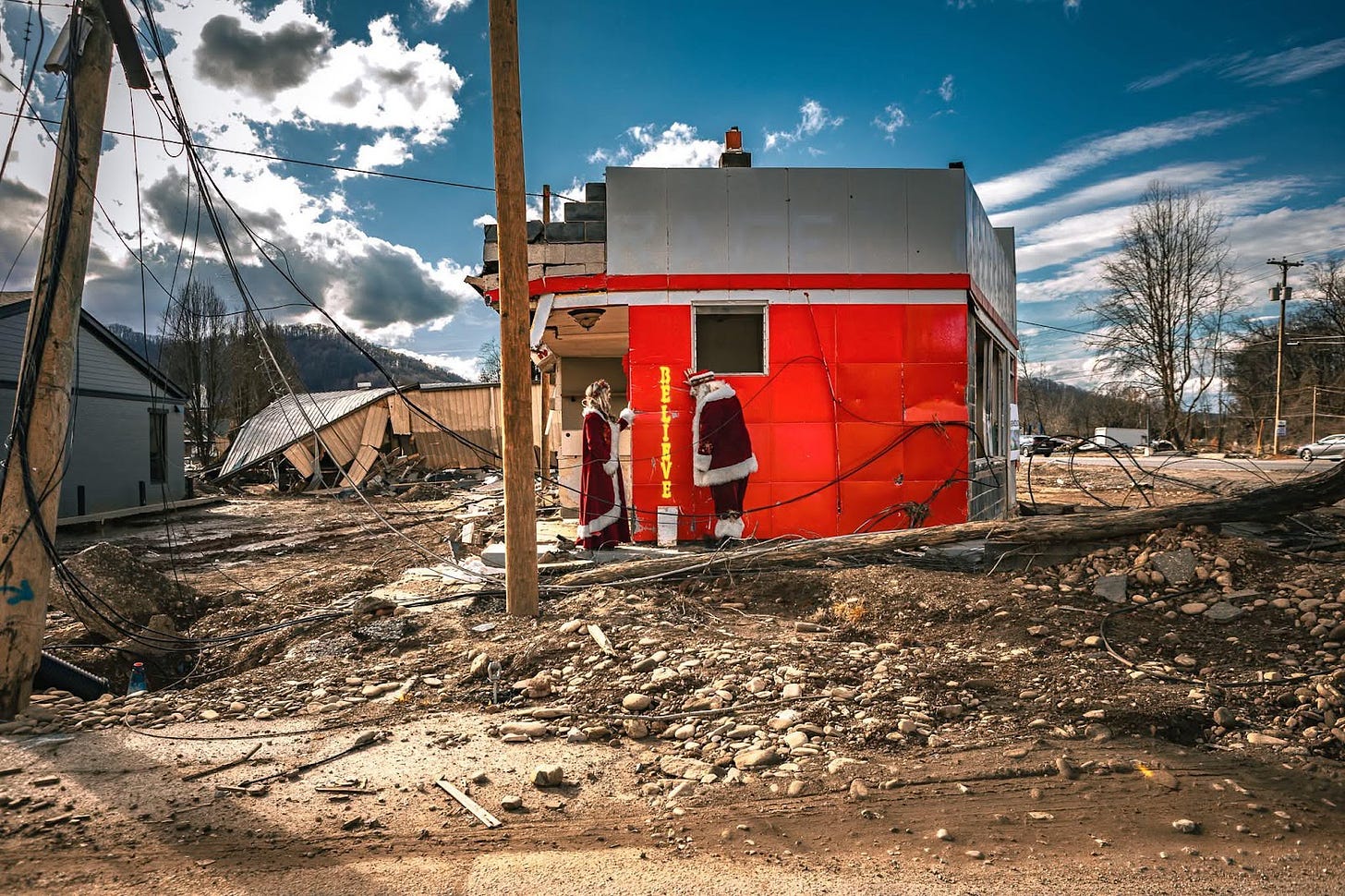In the mountains, holiday traditions met a new reality
Plus: Names of victims released; $1.6B approved for N.C.; FEMA housing aid ends tomorrow; Unemployment rises fastest in U.S.; Asheville makes New York Times’s 2025 travel list
You’re reading Mountain Updates, a free pop-up newsletter from The Charlotte Ledger examining the crisis and recovery in the N.C. mountains. Ledger subscribers can add Mountain Updates on their “My Account” page.
Sign up for free:
There were fewer lights and decorations, but I saw the holiday spirit endure in unexpected places
The Christmas spirit in Western North Carolina this season was solemn, as the area continues to recover from damage caused by Tropical Storm Helene in September. This photo, which was taken in Swannanoa, went viral on Facebook with more than 2.5 million views. (Photo courtesy of Rey Castillo Jr.)
By Lindsey Banks
There were a few moments over the holidays when things almost felt normal in Western North Carolina — sitting down and enjoying a meal at a restaurant, last-minute holiday shopping at the Asheville Mall, touring the Biltmore House and admiring the Christmas decorations, driving by churches hosting candlelight Christmas Eve services.
But then there were moments when it would all come rushing back in. The ghost of Helene still lingers in Western North Carolina and in my hometown of Swannanoa, which was one of the areas hardest hit by the storm.
The route to basically any restaurant or store passes by piles of debris — a mix of downed trees, scraps of building materials and vehicles and people’s belongings. A few main roads and bridges are still closed, forcing alternate routes to parts of town. Nonprofits are still stationed around the area, passing out free supplies and food. A few “comfort centers,” which are temporary relief stations, are still operable and allow people to take showers. Destroyed homes and buildings in harder-hit areas like Swannanoa or Biltmore Village brought silence to those in my car. Temporary camping trailers and tents are pitched around town. Open parks and walking trails are scarce.
The typical holiday spirit also rested heavier on the area. I noticed that fewer homes strung up outdoor Christmas lights and put out inflatables this year. Maybe it was because their homes were damaged, or because they didn’t feel in the Christmas spirit this year. I assume it was a combination of both.
And last week, after New Year's Day, a half-inch layer of snow dusted Black Mountain and Western North Carolina. For a fleeting moment, it was beautiful. The snow temporarily hid the destruction, and child-like giddiness resurfaced as I stuck my hand out of the car window to catch snowflakes. But then I drove by a tent covered in snow and remembered that snow means freezing temperatures and ice, and for those who are still living in temporary camping trailers and tents, snow is anything but comforting.
But Western North Carolinians did find a few bright spots this holiday season.
In Black Mountain, schools spent the last couple of weeks before the winter break handing out donated Christmas gifts. Every student received a free hoodie with the high school’s mascot logo printed on the front. My brother, a 9th-grader, received a free pair of On Cloud sneakers and a stuffed Christmas stocking. At Black Mountain Primary School, truckloads of toys, clothes and big-ticket items like bicycles were donated, and parents were invited to “shop” for their kids for Christmas.
The kids of the Swannanoa Valley were taken care of this Christmas in an emotionally overwhelming way. Helene did not stop Santa from sliding down chimneys.
Bellies were full on Christmas Day, too, to those who visited Blunt Pretzels, a pretzel shop in Swannanoa. The business has been cooking free meals every day since the storm, and that continued on Christmas and New Year’s Day.
The past three months have felt like an eternity while also frozen in time. When government officials announced in October that the road to recovery would be long, they weren’t exaggerating. Now that 2025 has arrived, with more perspective on how long clean-up and repairs are going to take, that finish line feels even farther away.
But the community is resilient. Folks who have grown deep roots in the valley are not giving up on their mountains. They’re not giving up and moving away. They’re supporting each other in any way they can, preparing for the months ahead.
My hope is that this time next year, 2024 will feel like light-years away.
Let’s check in on the rest of the region:
Names of deceased: North Carolina officials have released the names of 104 people killed by Tropical Storm Helene, marking the first comprehensive public acknowledgment of the storm’s fatalities. State efforts have reduced the number of missing people to fewer than 20. (Blue Ridge Public Radio)
Snowfall expected: Western North Carolina will receive anywhere from 2 to 8 inches of snowfall this weekend…
12,000 total people without safe housing: Gov. Josh Stein signed five executive orders to accelerate Helene recovery efforts in Western North Carolina, where over 12,000 residents remain without safe housing. The orders aim to speed up temporary housing availability, repair private roads and bridges and establish the Governor’s Recovery Office for Western North Carolina (GROW NC). Additional measures include creating a Division of Community Revitalization, forming an advisory committee, and granting extra leave for state employees to support recovery efforts. (Business NC)
And FEMA housing aid ends tomorrow: Around 3,500 households will lose FEMA’s Transitional Sheltering Assistance (TSA) as of Jan. 10, leaving many without temporary housing during winter storms. The program provided hotel stays for Tropical Storm Helene survivors, but some are now deemed ineligible due to habitable homes, lack of inspection or unresponsiveness. As of Monday, more than 5,600 households are living in hotel or motel rooms paid by FEMA. After Friday, about 2,100 families will remain eligible for housing assistance. (WLOS)
$1.6B for North Carolina: The Department of Housing and Urban Development announced $1.4 billion for North Carolina and $225 million for Asheville to help rebuild homes, businesses and communities affected by Helene. (WLOS)
New York Times names Asheville as a top travel destination: The New York Times released a list of 52 places to travel worldwide in 2025, and Asheville clinched the No. 16 spot. “In 2025, this Blue Ridge mountain town invites travelers to ‘plan a return trip with heart’ to celebrate new openings and reopenings,” the article says. On the list, Asheville sits between the Dolomite Mountains in Italy and the Magdalena River in Colombia.
Unemployment spikes: Asheville led the nation in year-over-year unemployment increases in the 12 months ending in November, according to new data from the Bureau of Labor Statistics. The Asheville area’s unemployment rate was 6.1% in November, up 3.4 percentage points from a year earlier.
Ingles lost nearly $35M: Ingles Markets reported $34.9 million in losses, including $30.4 million in damaged inventory and $4.5 million in property destruction. The storm disrupted operations at its Asheville distribution center and stores, contributing to a $1.4 million operating loss in the fourth quarter. While insurance is expected to cover part of the losses, future repairs, rebuilds and lost revenue remain significant challenges for the grocer. (North Carolina Tribune)
WATCH: Damage in Swannanoa and Asheville’s River Arts District lingers more than 3 months after storm
—
Lindsey Banks, a native of the Buncombe County town of Swannanoa, is a staff reporter with The Charlotte Ledger. Reach her at lindsey@cltledger.com.
How to help
Many organizations have deployed groups across the region, tasked with distributing food, water and supplies. You can donate to their efforts at the links below.
Hearts with Hands, a local disaster relief organization, has a donation page to provide food, supplies and water.
United Way of North Carolina has established a fund to help residents affected by the flooding.
MANNA Foodbank, which serves 16 counties in Western North Carolina, is accepting food, supplies and monetary donations. The organization’s warehouse on Swannanoa River Road in Asheville was damaged by the hurricane.
Samaritan’s Purse, which is headquartered in Boone, is scheduling volunteers to help with debris cleanup.
Operation Blessing has a donation page to provide food, supplies and water.
E4E Relief, a Charlotte-headquartered provider of emergency financial relief programs on behalf of corporations, is accepting donations for their newly established Hurricane Helene Community Fund, offering financial support to individuals with long-term impacts from Hurricane Helene.
Need to sign up for this e-newsletter? We offer a free version, as well as paid memberships for full access to all 4 of our local newsletters:
The Charlotte Ledger is a locally owned media company that delivers smart and essential news. We strive for fairness and accuracy and will correct all known errors. The content reflects the independent editorial judgment of The Charlotte Ledger. Any advertising, paid marketing or sponsored content will be clearly labeled.
◼️ About The Ledger • Our Team • Website
◼️ Newsletters • Podcast • Newcomer Guide • A Better You email series
◼️ Subscribe • Sponsor • Events Board • Merch Store • Manage Your Account
◼️ Follow us on Facebook, Instagram, X/Twitter, LinkedIn, Substack Notes





